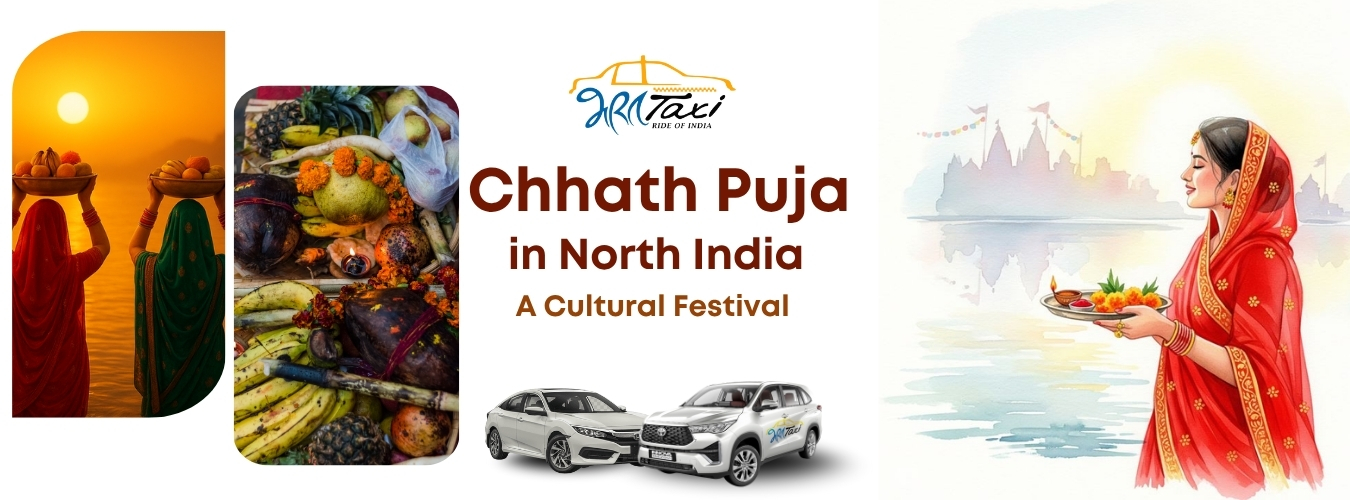Last Updated on October 26, 2025 by Raj Kishor Kannoujea
Chhath Puja in North India is the most popular cultural festival near Diwali. This festival shows love, faith, and devotion to nature and the God ‘Sun’ and his sister Goddess ‘Chhathi Maiya’. Along with Indian states like Bihar, Uttar Pradesh, and Jharkhand, you will get the shadow of this celebration in each part of the country now. Some parts of Nepal also celebrate this festival with deep respect and great enthusiasm.
You can see the Chhath Puja in cities like Delhi, Patna, Varanasi, and Lucknow with great faith in Chhath maa. With the help of this festival, you can see everywhere the local culture of Uttar Pradesh and Bihar. And, to travel around easily, book an affordable taxi service in India for a family ride.
Table of Contents
1. Chhath Puja Overview
The word “Chhath” means “sixth,” as the festival comes on the sixth day after Diwali. There is a variety of beliefs in locals, but especially, it is the worship & arghya of Surya Dev (the Sun God) and the Vrat of his sister ‘Chhathi Maiya’.
It is said that when this world was created, the Goddess nature divided herself into six parts, and the sixth Goddess is called “Chhathi Maiya.”
Women and men both keep fast of Chhathi Maiya for 2 days, and on the third day, when the sun rises, they offer ‘Arghya’- water-offering worship to the God. Praying to the Sun, you get good health, prosperity, and happiness along with your family.
The Chhath Puja is also a way to thank nature for supporting life on earth. So people also use daily-useable and local food & fruits along with sugarcane, Thekua, Chiwda, Nariyal, Suthni, etc. The fasting (Nirajal Vrat) makes the health better based on the natural view.
2. Another Historical belief of Chhath Puja
Historically, its root comes from the Rigveda, where sages performed Surya worship for energy & strength. In the Mahabharat, Karna, the son of the Sun God and Kunti, used to do Chhath Puja on the banks of the Ganga. Another belief is that Draupadi and the Pandavas performed the Chhath Puja during their exile to regain peace and power.
Over time, the Chhath Puja in North India has become a simple and natural form with a strong part of people’s culture. Especially in Bihar and eastern Uttar Pradesh, it is a huge celebration. On the sixth day of Diwali, you will get a huge crowd of pilgrims at a pond-side or the banks of the river.
3. The Four Days of Chhath Puja
While coming to the Chhath Puja in North India, it is a four-day festival. Each day of the festival has its own meaning and rituals.
Day 1: Nahay Khay (Bath and Eat)
The first day, the beginning of the ritual, Women take a holy bath in the river or at home. They prepare pure vegetarian food — usually rice, pumpkin, and gram dal — cooked on a new Chulha(local earthen stove). The person who keeps fast takes the food only once that day, as it marks the start of the fast.
Day 2: Kharna (Fasting and Offering)
On this day, Women and Men keep a strict fast from sunrise to sunset without water (Nirjala Vrat). In the evening, they offer Rasiyaw (gur kheer) and chapati to the Sun and then eat after the puja.
Day 3: Sandhya Arghya (Evening Offering)
Sandhya Arghya (the third day of Chhath Puja) is the most important day of the fast and Puja. Men and Women, along with their families, gather near rivers, ponds, or ghats. Women wear traditional sarees, usually in bright colours like orange or yellow. At sunset, they stand in water and offer arghya (prayers) to the setting sun. The sight of hundreds of diyas floating on water truly creates a magical view on the Ghats.
Day 4: Usha Arghya (Morning Offering)
The final day(fourth day) begins before sunrise as early as you can. Devotees again gather at the water-side to offer prayers to the rising Sun. It is the time of the end of the fast. After offering Arghya puja, they share prasad, usually thekua (a sweet made from wheat flour and jaggery), fruits, and coconut with the people present there.
Read more: Chhath Puja and Vrat in India
4. Rituals and Significance
Chhath Puja in North India is a special festival because of its discipline and purity. People who keep fast follow strict rules such as bathing in holy rivers, wearing clean clothes, eating only vegetarian food, and sleeping on a different & pure bed. The fast is the toughest part, as men and women go without water for over 36 hours. Despite this, they do this fast with full devotion and pleasure.
The festival of Chhath Puja in North India teaches patience, respect for nature, and strong faith. It also spreads the message of equality, where people from all backgrounds come together on riverbanks to pray. There are no idols, no priests, and no discrimination, which makes Chhath Puja one of the purest festivals in the country.
5. Places to Visit on Chhath Puja Celebration
The most famous celebration happens especially in Patna. Along with Patna, you can visit Gaya, Muzaffarpur, Gopalganj and Arrah in Bihar. The ghats along the Ganga river become full of lights and Diyas in the evening and morning. In Uttar Pradesh, you can visit Varanasi, Lucknow, and Gorakhpur, where you can also see the grand celebrations.
In cities like Delhi, Mumbai, and Kolkata, there are huge celebrations because people from UP and Bihar celebrate here with great enthusiasm, as well as locals. You will also find here ghats on riverbanks, ponds, or even rooftops to perform these festive rituals. The sight of so many pilgrims standing in water, singing traditional Chhath Maiya songs, and offering prayers together shows how deeply Chhath Puja is connected with faith and unity.

